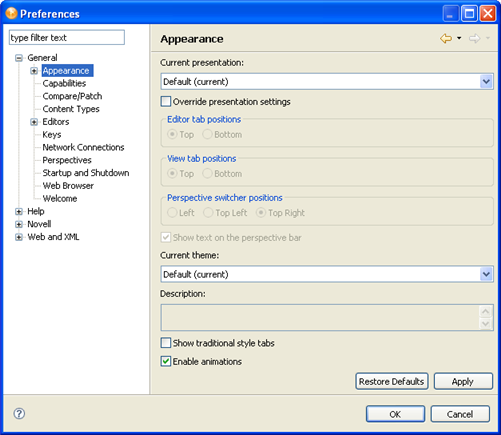19.2 General
The General preferences page includes the following settings:
Table 19-1 Preferences: General
Additionally, the following preferences categories appear as General sub-pages:
19.2.1 Appearance
Figure 19-1 Preferences: General > Appearance

Table 19-2 Preferences: General > Appearance
Colors and Fonts
To change a color:
-
Underexpand .
-
Select .
-
Expand an option (for example, ).
-
Select an item (for example, ).
-
Click the color button.

-
Select a color from the Color palette, then click .
To change a font:
-
Under , expand .
-
Select .
-
Expand an option (for example, ).
-
Select an item (for example, ).
-
Click .
-
Select a font, style, and size, then click .
19.2.2 Capabilities
Currently, this section relates to Eclipse functionality. Designer functionality will be implemented later.
Prompt When Enabling Capabilities
Eclipse lets you turn off capabilities. However, Eclipse sometimes detects that you need the capability, depending on how you use the product, and automatically turns the capability on again. You can select to receive a message when this happens. This feature doesn’t apply to Designer 3.0.
19.2.3 Compare/Patch
This Eclipse functionality customizes the behavior of the comparison editor. When you select to compare or synchronize two or more resources in the Workbench, one or more comparison editors usually open.
Table 19-3 Preferences: General > Compare/Patch General Tab Settings
For information about settings on the tab, refer to the Eclipse documentation.
19.2.4 Content Types
Table 19-4 Preferences: General > Content Types
19.2.5 Editors
Table 19-5 Preferences: General > Editors
File Associations
Enables you to associate editors (whether they are internally installed in the Designer, or an external application) with file types (extensions) so that you can edit files.
To find out which editor is associated with a file type, select the file type. For example, a .docgen file type is associated with Style editor, but a .scriptpolicy file type is associated with Policy Builder.
To associate an additional editor with a file type:
-
Select the file type.
-
In the pane, click .
-
Select an additional editor, then click twice.
To add a file type:
-
In the pane, click .
-
Type the extension (for example, .doc) for the file type, then click .
-
In the pane, click .
-
Select an editor for that file type, then click twice.
Hex Editor
Enables you to configure Designer’s hex editor environment, including font, font style, and colors. You can also associate, or disassociate, the hex editor from Designer’s registered file extensions, and enable hex editor logging.
Structured Text Editors
For information on structured text editors, refer to the Eclipse documenation.
Text Editors
Table 19-6 Preferences: General > Text Editors
For additional information on text editors, see the Eclipse documentation.
19.2.6 Keys
Enables you to view a table of all of the keyboard mappings, change those mappings, and add new mappings.
19.2.7 Network Connections
Enables you to configure a manual proxy configuration if you use a proxy server to access the Internet. The default is a direct connection to the internet.
19.2.8 Perspectives
Table 19-7 Preferences: General > Perspectives
19.2.9 Startup and Shutdown
Table 19-8 Preferences: General > Startup and Shutdown
19.2.10 Web Browser
Table 19-9 Preferences: General > Web Browser
19.2.11 Welcome
Table 19-10 Preferences: General > Welcome
|
Setting |
Description |
|---|---|
|
|
Enables you to select the theme that appears when you click > . |
|
|
Adds tabs (for example, ) on the Welcome properties page. You add functionality by customizing these tabs. |
For information about the Overview and What’s New tabs, refer to the Eclipse documentation.
